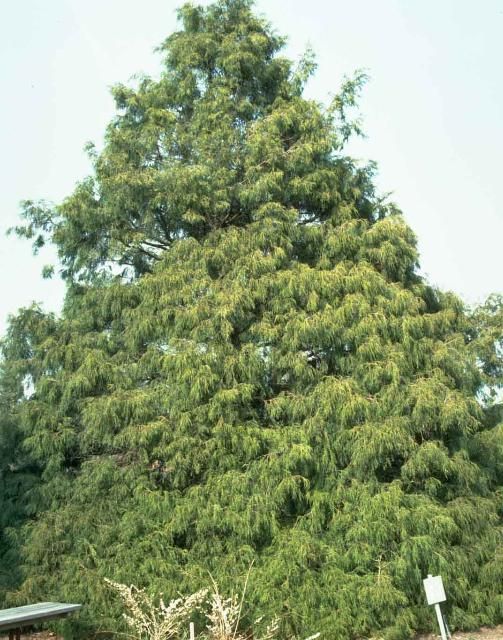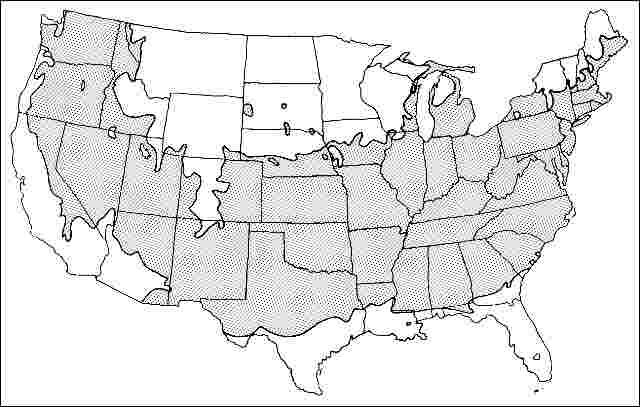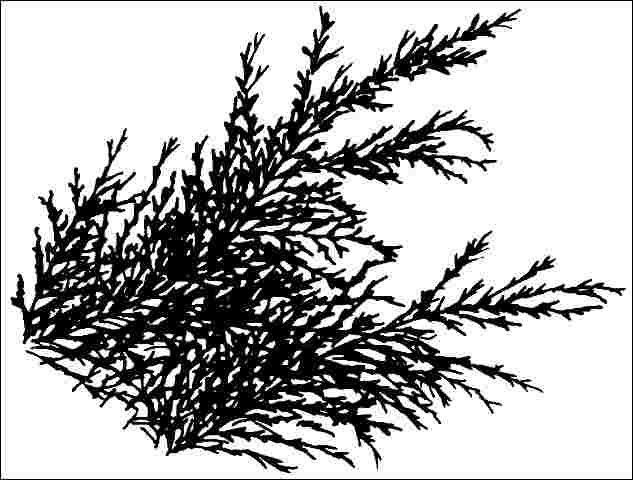Introduction
Sawara falsecypress grows slowly to about 30 feet high and 20 feet wide at the base of the tree, and has thin, horizontal to pendulous branches of a very fine texture that form a dense, broad pyramid. The very attractive, reddish-brown, smooth, peeling bark is complemented nicely by the medium-green foliage, but is usually not seen since lower branches are normally left on the tree and hide the trunk. This tree is quite popular in oriental and rock gardens, but can grow to be quite wide, so allow plenty of room for best form and development.

Credit: Ed Gilman, UF/IFAS
General Information
Scientific name: Chamaecyparis pisifera
Pronunciation: kam-eh-SIP-uh-riss pye-SIFF-er-uh
Common name(s): Sawara falsecypress
Family: Cupressaceae
USDA hardiness zones: 4B through 8B (Figure 2)
Origin: not native to North America
Invasive potential: not assessed/incomplete assessment
Uses: specimen; bonsai

Description
Height: 25 to 35 feet
Spread: 20 to 30 feet
Crown uniformity: symmetrical
Crown shape: pyramidal
Crown density: dense
Growth rate: slow
Texture: fine
Foliage
Leaf arrangement: opposite/subopposite (Figure 3)
Leaf type: simple
Leaf margin: entire
Leaf shape: scale-like
Leaf venation: none, or difficult to see
Leaf type and persistence: evergreen
Leaf blade length: less than 2 inches
Leaf color: green
Fall color: no color change
Fall characteristic: not showy

Flower
Flower color: unknown
Flower characteristics: not showy
Fruit
Fruit shape: round, cone
Fruit length: less than 0.5 inch
Fruit covering: dry or hard
Fruit color: brown
Fruit characteristics: does not attract wildlife; not showy; fruit/leaves not a litter problem
Trunk and Branches
Trunk/bark/branches: branches droop; showy; typically one trunk; thorns
Pruning requirement: little required
Breakage: resistant
Current year twig color: green, brown
Current year twig thickness: thin
Wood specific gravity: unknown
Culture
Light requirement: full sun, partial sun, or partial shade
Soil tolerances: clay; sand; loam; acidic; well-drained
Drought tolerance: moderate
Aerosol salt tolerance: low
Other
Roots: not a problem
Winter interest: no
Outstanding tree: no
Ozone sensitivity: unknown
Verticillium wilt susceptibility: resistant
Pest resistance: resistant to pests/diseases
Use and Management
It is best used as a specimen planting for a large, open area of a commercial or large residential landscape. Although it looks great in the nursery, it often grows too wide for a small residential lot.
Sawara falsecypress should be grown in full sun to partial shade on moist, well-drained, non-alkaline soil in regions with moderate to high humidity. Although moderately drought tolerant, it is not especially happy in very hot summers unless provided with some irrigation. The plants transplant reasonably well when root pruned. It must be given full sun so lower branches remain on the tree to provide the best appearance. Plant looks sloppy if lower branches die or are removed, and this is not recommended. Locate the plant properly to eliminate the need for pruning.
Propagation is by cuttings.
Pests
Usually there are no pests of major concern, perhaps bagworm.
Juniper scale is best controlled by applying pesticides when the crawlers are active.
The bagworm webs dead foliage together to make a nest. The covering makes the insect difficult to control. Use sprays of Bacillus thuringiensis. The nests can be picked off by hand when infestations are small.
Diseases
Usually there are no diseases of major concern.
Phomopsis blight can be a problem on young plants in nurseries or old plants in landscape situations. In young plants, branch tips turn brown and die back until the whole branch or young tree is killed. Tip blight infects trees during wet weather. The disease causes sooty pustules on the leaves, bark, and cones. Trees over five years old are less susceptible. When older trees in landscapes are affected, entire trees are seldom killed.
Scorch may look like a disease but is caused by excessive direct sun, freezing stress, drought, or mites. Freezing stress can be prevented by shading small plants in winter.